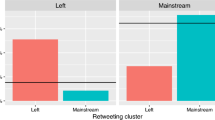Abstract
In this paper, the influence of interventions on Twitter users is studied. We define influence in (a) number of participants, (b) size of the audience, (c) amount of activity, and (d) reach. Influence is studied for four different target groups: (a) politicians, (b) journalists, (c) employees and (d) the general public. Furthermore, two types of interventions are studied: (a) by all Twitter users (i.e., uncontrolled interventions), and (b) those tweeted by an organization that benefits from any resulting influence (i.e., controlled interventions). As a case study, tweets about a large Dutch governmental organization are used. Results show a relation between the number of uncontrolled interventions and influence in all four target groups, for each of the defined types of influence. Controlled interventions show less influence: significant influence was found for the general public, but influence for politicians and employees was only mildly significant, and no influence was found for journalists. The effect found for uncontrolled interventions, however, suggests that this influence is indeed reachable for some target groups, even when the number of interventions is small, and very well reachable for all target groups, provided the number of interventions is large enough. In addition to this, we found that interventions influence groups to a different extent. Own employees were influenced strongest, differing significantly from the other groups.



Similar content being viewed by others
References
Bakshy E, Rosenn I, Marlow C, Adamic L (2012) The role of social networks in information diffusion. In: Proceedings of the 21st international conference on World Wide Web, pp 519–528
Cacioppo JT, Petty RE (1980) Persuasiveness of communications is affected by exposure frequency and message quality: a theoretical and empirical analysis of persisting attitude change. Current Issues Research Advert 3(1):97–122
Cha M, Haddadi H, Benevenuto F, Gummadi PK (2010) Measuring user influence in Twitter: the million follower fallacy. ICWSM 10:10–17
Cialdini RB (2001) Influence: science and practice, vol 4. Allyn and Bacon, Boston
Dugan L (2011) 5 Tools to measure your Twitter influence. http://www.mediabistro.com/alltwitter/5-tools-to-measure-your-twitter-influence_b3570
Van der Eijk C (2000) The Netherlands: media and politics between segmented pluralism and market forces. In: Gunther R, Mughan A (eds.) Democracy and the media: a comparative perspective, chap. 9, Cambridge University Press, Cambridge, pp 303–342
Grabowicz PA, Ramasco JJ, Moro E, Pujol JM, Eguiluz VM (2012) Social features of online networks: the strength of intermediary ties in online social media. PLoS One 7(1):E29358
Huberman BA, Romero DM, Wu F (2009) Social networks that matter: Twitter under the microscope. First Monday 14(1)
Kaptein M, Nass C, Parvinen P, Markopoulos P (2013) Nice to know you: familiarity and influence in social networks. In: Proceedings of the 46th Hawaii International Conference on System Sciences (HICSS), pp 2745–2752
Kempe D, Kleinberg J, Tardos É (2003) Maximizing the spread of influence through a social network. In: Proceedings of the ninth ACM SIGKDD international conference on Knowledge discovery and data mining (KDD), pp 137–146
Knowles ES, Linn JA (2003) Resistance and persuasion. Lawrence Erlbaum
Mainwaring S (2011) The new power of consumers to influence brands. http://www.forbes.com/sites/simonmainwaring/2011/09/07/the-new-power-of-consumers-to-influence-brands
Mehta R, Mehta D, Chheda D, Shah C, Chawan PM (2012) Sentiment analysis and influence tracking using Twitter. Int J Adv Research Comput Sci Electron Eng 1(2):72–79
Meyer T, Hinchman LP (2002) Media democracy: how the media colonize politics. Polity Press, Oxford
Pornpitakpan C (2004) The persuasiveness of source credibility: a critical review of five decades’ evidence. J Appl Social Psychol 34(2):243–281
Rosenman ETR (2012) Retweets–but not just retweets: Quantifying and predicting influence on Twitter, Bachelor’s thesis, applied mathematics. Harvard College, Cambridge
Rotemberg JJ (1999) A heuristic method for extracting smooth trends from economic time series. Tech. rep, National Bureau of Economic Research, Inc
Sassenberg K, Boos M (2003) Attitude change in computer-mediated communication: effects of anonymity and category norms. Group Process Intergroup Relat 6(4):405–422
Sullivan D (2011) Why “second chance” tweets matter: After 3 hours, few care about socially shared links. http://searchengineland.com/why-second-chance-tweets-matter-after-3-hours-few-care-about-socially-shared-links-92125
Thelwall M, Buckley K, Paltoglou G, Cai D, Kappas A (2010) Sentiment strength detection in short informal text. J Am Soc Inf Sci Technol 61(12):2544–2558
Wijn R, van den Bos K (2010) On the social-communicative function of justice: the influence of communication goals and personal involvement on the use of justice assertions. Personal Soc Psychol Bulletin 36(2):161–172
Yang J, Counts S (2010) Predicting the speed, scale, and range of information diffusion in Twitter. In: Proceedings of the Fourth International AAAI Conference on Weblogs and Social Media
Acknowledgments
This research has been funded by the TNO Enabling Technology Program “Behavior and Innovation”. The authors would furthermore like to thank Olav Aarts, Jan Maarten Schraagen, Nadia Jansen and Tineke Hof for their efforts to make this research possible.
Author information
Authors and Affiliations
Corresponding author
Rights and permissions
About this article
Cite this article
van Maanen, PP., Wijn, R. & Boertjes, E. The effect of interventions on Twitter in four target groups using different measures of influence. Soc. Netw. Anal. Min. 4, 192 (2014). https://doi.org/10.1007/s13278-014-0192-6
Received:
Revised:
Accepted:
Published:
DOI: https://doi.org/10.1007/s13278-014-0192-6




